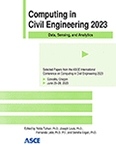Towards an Intelligent Automated Building Code Compliance System
Publication: Computing in Civil Engineering 2023
ABSTRACT
An automated intelligent building code compliance methodology using a flexible and adaptable BIM authoring tool is presented. The method is designed to use minimal computing resources in different contexts of code applications. The innovation utilizes the complete corpus of the building code as input for compliance checking. Current research developments use specific sections of the code that focus only on parts of the building code without making inferences to subsections or other building codes. The approach uses natural language processing techniques to generate an easy-to-process output [simplified comma-separated value (CSV) file] for rapid interpretation and further manipulation for review and modifications of the generated ruleset, thereby increasing the accuracy of the rule when needed. Simultaneously, the approach prevents the recreation of rulesets when inferred sections were previously generated, to ensure the integrity of IBC sections and subsections structure. This paper presents the data extraction and processing approach that generates computer-readable rules using building code paragraphs. Future work will incorporate methods to fully process tables and figures to generate a comprehensive check and inference in compliance.
Get full access to this article
View all available purchase options and get full access to this chapter.
REFERENCES
Amor, R., and Dimyadi, J. (2021). The promise of automated compliance checking. Developments in the Built Environment, 5, 100039. https://doi.org/10.1016/j.dibe.2020.100039.
Beach, T. H., Rezgui, Y., Li, H., and Kasim, T. (2015). A rule-based semantic approach for automated regulatory compliance in the construction sector. Expert Systems with Applications, 42(12), 5219–5231. doi:https://doi.org/10.1016/j.eswa.2015.02.029.
Chowdhary, K. R. (2020). Natural Language Processing. In K. R. Chowdhary (Ed.), Fundamentals of Artificial Intelligence (pp. 603–649). New Delhi: Springer India.
Delis, E. A., and Delis, A. (1995). Automatic Fire-Code Checking Using Expert-System Technology. Journal of Computing in Civil Engineering, 9(2), 141–156. doi:https://doi.org/10.1061/(ASCE)0887-3801(1995)9:2(141).
Ding, Y., Ma, J., and Luo, X. (2022). Applications of natural language processing in construction. Automation in Construction, 136, 104169. https://doi.org/10.1016/j.autcon.2022.104169.
Eastman, C., Lee, J.-M., Jeong, Y.-S., and Lee, J.-K. (2009). Automatic rule-based checking of building designs. Automation in Construction, 18(8), 1011–1033. doi:https://doi.org/10.1016/j.autcon.2009.07.002.
Fuchs, S., and Amor, R. (2021). Natural Language Processing for Building Code Interpretation: A Systematic Literature Review. Paper presented at the Proc. of the Conference CIB W78.
International Code Council. (2018). International Building Code: International Code Council.
Ismail, A. S., Ali, K. N., and Iahad, N. A. (2017, 16-17 July 2017). A Review on BIM-based automated code compliance checking system. Paper presented at the 2017 International Conference on Research and Innovation in Information Systems (ICRIIS).
Mutis, I. (2012). Framework for Semantic Reconciliation of Construction Project Information. Journal of Information Technology in Construction, 17(1), 24.
Nawari, N. O. (2019). A Generalized Adaptive Framework (GAF) for Automating Code Compliance Checking. Buildings, 9(4), 86. Retrieved from https://www.mdpi.com/2075-5309/9/4/86.
Xue, X., and Zhang, J. (2020). Building Codes Part-of-Speech Tagging Performance Improvement by Error-Driven Transformational Rules. Journal of Computing in Civil Engineering, 34(5), 04020035. doi:https://doi.org/10.1061/(ASCE)CP.1943-5487.0000917.
Yang, Q. Z., and Xu, X. (2004). Design knowledge modeling and software implementation for building code compliance checking. Building and Environment, 39(6), 689–698. doi:https://doi.org/10.1016/j.buildenv.2003.12.004.
Zhang, J., and El-Gohary, N. M. (2016). Semantic NLP-Based Information Extraction from Construction Regulatory Documents for Automated Compliance Checking. Journal of Computing in Civil Engineering, 30(2), 04015014. doi:https://doi.org/10.1061/(ASCE)CP.1943-5487.0000346.
Zhang, J., and El-Gohary, N. M. (2017). Integrating semantic NLP and logic reasoning into a unified system for fully-automated code checking. Automation in Construction, 73, 45–57.
Zheng, Z., Zhou, Y.-C., Lu, X.-Z., and Lin, J.-R. (2022). Knowledge-informed semantic alignment and rule interpretation for automated compliance checking. Automation in Construction, 142, 104524. https://doi.org/10.1016/j.autcon.2022.104524.
Zhou, P., and El-Gohary, N. (2017). Ontology-based automated information extraction from building energy conservation codes. Automation in Construction, 74, 103–117. doi:https://doi.org/10.1016/j.autcon.2016.09.004.
Zhou, Y.-C., Zheng, Z., Lin, J.-R., and Lu, X.-Z. (2022). Integrating NLP and context-free grammar for complex rule interpretation towards automated compliance checking. Computers in Industry, 142, 103746. https://doi.org/10.1016/j.compind.2022.103746.
Information & Authors
Information
Published In
History
Published online: Jan 25, 2024
ASCE Technical Topics:
- Architectural engineering
- Building codes
- Building information modeling
- Building management
- Building systems
- Buildings
- Business management
- Computing in civil engineering
- Construction engineering
- Construction management
- Construction methods
- Innovation
- Practice and Profession
- Smart buildings
- Standards and codes
- Structural engineering
- Structures (by type)
Authors
Metrics & Citations
Metrics
Citations
Download citation
If you have the appropriate software installed, you can download article citation data to the citation manager of your choice. Simply select your manager software from the list below and click Download.
